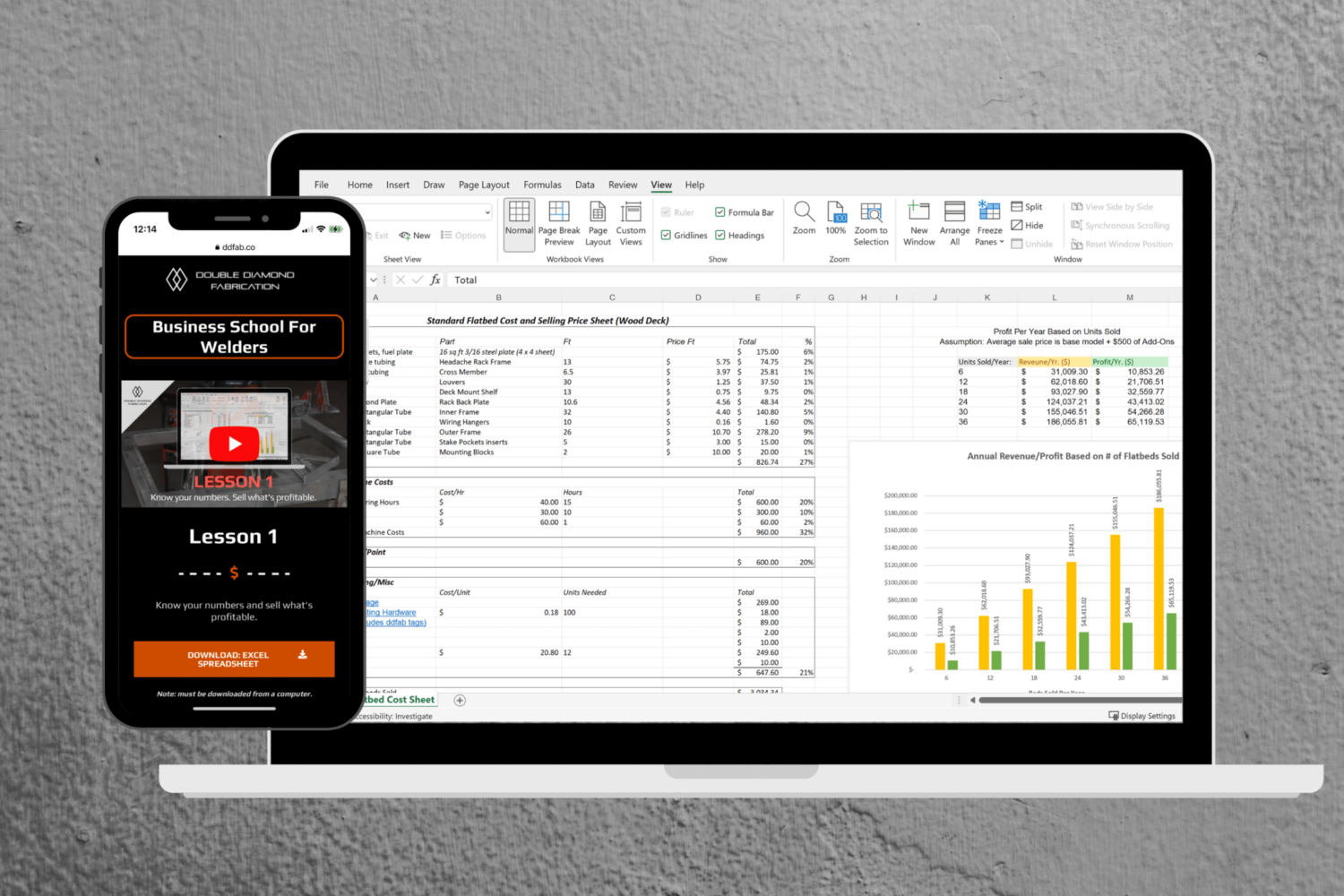Apply for the flatbed dealer program >
Business School for Welders >
- Today we’ll cover how to set your selling prices and profit margins for whatever you sell in your welding shop.
- Most of you will know this, but in case you don’t let’s define revenue and the two different types of profit.
- Revenue: the total amount of money your business brings in, also known as your top line. If you add together the selling price of everything you sold last year, that number is your annual revenue.
- Gross Profit: Your selling price minus the cost to produce your products and services (COGS). This includes all materials and labor related to producing your product. This does not account for overhead, or your fixed costs such as rent or insurance.
- Net Profit: the money your business made after ALL expenses were paid. If you had $200k in revenue and $150k in expenses, your profit is $50k. If you are self employed, generally your salary is not an expense, that is part of profit. Net profit is the number that matters the most.
- Now, let’s talk about the importance of profit, and the unimportance of revenue.
- Most people brag about their revenue, or top line. This is kind of a false representation, because just because you bring in a lot of money each year doesn’t mean you made anything in profit.
- Profit is what makes you (the owner) rich and gives you freedom, which is the ultimate purpose of business. Revenue doesn’t do either of those. If you have a business that brings in $3M and has a profit of $50k, you don’t own a business, you own a high stress hobby.
- We base the health of our business on PROFIT, and we consider two things:
- The dollar amount of profit we are generating, this should grow over time.
- Our profit as a percentage of revenue. Currently we run between a 30% and 40% net profit margin. This number should stay as high as possible, we have a minimum threshold of 25% at our company. If we run at below 25% for any period of time, we raise prices or adjust our expenses down to make sure our net profit percent stays above 25%.
- So let’s get into how we set our selling prices and profit margin for what we sell and how it has worked well for us.
- We start with the end in mind, meaning we want the business to have a minimum net profit margin of 25%. For that to happen, our gross profit margin has to be about 10% higher than that or (35%) because overhead costs are going to eat up some of that margin before you get to your net profit margin for the year.
- Here’s an example. We sell flatbeds, currently we make a 45% gross profit margin on those flatbeds. That accounts for the cost of materials and labor to produce that flatbed. However, we still have to subtract the cost of our fixed costs such as rent and insurance. Once we pay for all of those things, at the end of the month we come to around a 35% net margin. Moral of the story, if you want your business to have a certain net profit percentage, such as 25%, your gross margin on your actual product or services has to be higher, because overhead will eat up some of your margin.
- So here’s the guideline I’ll give you from what we’ve learned. A 35% or 40% gross profit margin is generally a good place to start with the products you sell. If you can’t sell your product and make that margin, you should quit offering that product/service.
- The last piece of this is that in order for this to work you have to be correctly costing your products. If you have no idea how to do this, check out our business school for welders program below. It has a very simple to use system that works for ANY product or service sold from a welding shop that will give you an EXACT cost and selling price for anything you sell. Once you know your numbers, you know your business. So feel free to check that out, we’ve had lots of shop owners go through it, and it has a money back guarantee.
- That covers todays topic, a couple quick takeaways:
- Revenue is not important, profit is important. That’s what makes you as the owner rich and have freedom. Don’t get in the trap of chasing revenue and ignoring profit, you’ll be stressed with no money.
- When you set your selling prices, start with the end in mind and what amount of profit you want your business to make. If you want a 25% margin, then your gross margin at the product level has to be around 10% higher than that. If that pushes your selling prices to a point that you can’t sell the product, quit doing it, you didn’t start your business to be broke.
- None of this works unless you have an accurate knowledge of your numbers and costs of your products or services. Make sure you have a reliable way to cost everything you sell, and if this is totally foreign to you, check out our business school for welders program below.
- Thanks for watching, have a great week.

